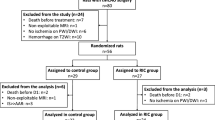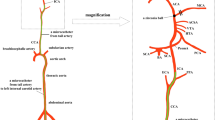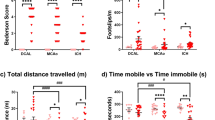Abstract
Animal models are required to study the pathogenesis of brainstem ischemia and to develop new therapeutic approaches to promote functional recovery after ischemia in humans. Few models of brainstem ischemia are available, and they show great variability or cause early lethality. New, reliable animal models are therefore needed. By selectively ligating four points of the lower basilar artery, we developed a new focal basilar artery occlusion model that causes a localized brainstem ischemic lesion in female Sprague–Dawley rats. Analysis of ischemic lesion volume and neurological deficits over a period of 28 d showed that the rats present symptoms specific to this type of stroke while the ischemic lesion remains relatively unchanged over time. This procedure allows higher survival rates and extended observation periods compared with other models of brainstem ischemia. The procedure takes ~40 min, can be performed by researchers with basic surgical skills and does not require specialized surgical equipment. This protocol is highly reliable and will be useful to evaluate new therapeutic approaches to promote functional recovery in patients with brainstem ischemia.
This is a preview of subscription content, access via your institution
Access options
Subscribe to this journal
We are sorry, but there is no personal subscription option available for your country.
Buy this article
- Purchase on Springer Link
- Instant access to full article PDF
Prices may be subject to local taxes which are calculated during checkout






Similar content being viewed by others
References
Mattle, H. P., Arnold, M., Lindsberg, P. J., Schonewille, W. J. & Schroth, G. Basilar artery occlusion. Lancet Neurol. 10, 1002–1014 (2011).
Archer, C. R. & Horenstein, S. Basilar artery occlusion: clinical and radiological correlation. Stroke 8, 383–390 (1977).
Pfefferkorn, T. et al. Staged escalation therapy in acute basilar artery occlusion: intravenous thrombolysis and on-demand consecutive endovascular mechanical thrombectomy: preliminary experience in 16 patients. Stroke 39, 1496–1500 (2008).
Arnold, M. et al. Clinical and radiological predictors of recanalisation and outcome of 40 patients with acute basilar artery occlusion treated with intra-arterial thrombolysis. J. Neurol. Neurosurg. Psychiatry 75, 857–862 (2004).
Vergouwen, M. D. et al. Time is brain(stem) in basilar artery occlusion. Stroke 43, 3003–3006 (2012).
Dewar, D., Yam, P. & McCulloch, J. Drug development for stroke: importance of protecting cerebral white matter. Eur. J. Pharmacol 375, 41–50 (1999).
Yam, P. S. et al. Topographical and quantitative assessment of white matter injury following a focal ischaemic lesion in the rat brain. Brain Res. Brain Res. Protoc 2, 315–322 (1998).
Lekic, T. & Ani, C. Posterior circulation stroke: animal models and mechanism of disease. J. Biomed. Biotechnol. 2012, 587590 (2012).
Richard Green, A., Odergren, T. & Ashwood, T. Animal models of stroke: do they have value for discovering neuroprotective agents? Trends Pharmacol. Sci. 24, 402–408 (2003).
Ayala, G. F. & Himwich, W. A. Subtemporal approach to the basilar artery in the dog. J. Appl. Physiol. 15, 1150–1151 (1960).
Yamada, K., Hayakawa, T., Yoshimine, T. & Ushio, Y. A new model of transient hindbrain ischemia in gerbils. J. Neurosurg. 60, 1054–1058 (1984).
Namioka, A. et al. Intravenous infusion of mesenchymal stem cells for protection against brainstem infarction in a persistent basilar artery occlusion model in the adult rat. J. Neurosurg. 131, 1308–1316 (2019).
Kuwabara, S., Uno, J. & Ishikawa, S. A new model of brainstem ischemia in dogs. Stroke 19, 365–371 (1988).
Wojak, J. C., DeCrescito, V. & Young, W. Basilar artery occlusion in rats. Stroke 22, 247–252 (1991).
Fujishima, M., Scheinberg, P. & Reinmuth, O. M. Effects of experimental occlusion of the basilar artery by magnetic localization of iron filings on cerebral blood flow and metabolism and cerebrovascular responses to CO2 in the dog. Neurology 20, 925–932 (1970).
Oki, S., Shima, T. & Uozumi, T. Experimental brain stem infarction in the dog—observation of the course. Neurol. Med. Chir. 22, 253–261 (1982).
Amiridze, N., Gullapalli, R., Hoffman, G. & Darwish, R. Experimental model of brainstem stroke in rabbits via endovascular occlusion of the basilar artery. J Stroke Cerebrovasc. Dis. 18, 281–287 (2009).
Nakahara, T., Oki, S., Muttaqin, Z., Kuwabara, S. & Uozumi, T. A new model of brainstem ischemia by embolization technique in cats. Neurosurg. Rev. 14, 221–229 (1991).
Tatu, L., Moulin, T., Bogousslavsky, J. & Duvernoy, H. Arterial territories of human brain: brainstem and cerebellum. Neurology 47, 1125–1135 (1996).
Graeff, F. G. & Silveira Filho, N. G. Behavioral inhibition induced by electrical stimulation of the median raphe nucleus of the rat. Physiol. Behav. 21, 477–484 (1978).
Modianos, D. T. & Pfaff, D. W. Brain stem and cerebellar lesions in female rats. I. Tests of posture and movement. Brain Res. 106, 31–46 (1976).
Murray, E. A. & Coulter, J. D. Organization of tectospinal neurons in the cat and rat superior colliculus. Brain Res. 243, 201–214 (1982).
Acknowledgements
This work was supported in part by JSPS KAKENHI (grant 16K10730 to O.H..), the AMED Translational Research Network Program (JP16lm0103003 to M.S.) and Merit Review Award 1 I01 BX003190 from the US Department of Veterans Affairs BLRD and the RRD Services (to J.D.K.). We thank M. Yamaguchi and M. Kimura for their excellent technical assistance.
Author information
Authors and Affiliations
Contributions
A.N., M.S. and O.H. conceptualized experiments. A.N. and T.N. performed all experiments. A.N. and M.S. analyzed the data. A.N., M.S., J.D.K. and O.H. wrote the manuscript.
Corresponding author
Ethics declarations
Competing interests
The authors declare no competing interests.
Additional information
Publisher’s note Springer Nature remains neutral with regard to jurisdictional claims in published maps and institutional affiliations.
Supplementary information
Supplementary Information
Supplementary Figure 1 and Supplementary Methods.
Rights and permissions
About this article
Cite this article
Namioka, A., Namioka, T., Sasaki, M. et al. Focal brainstem infarction in the adult rat. Lab Anim 50, 97–107 (2021). https://doi.org/10.1038/s41684-021-00722-1
Received:
Accepted:
Published:
Issue Date:
DOI: https://doi.org/10.1038/s41684-021-00722-1



